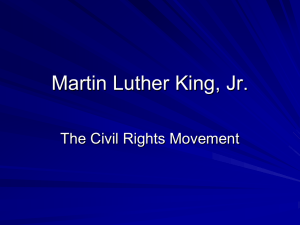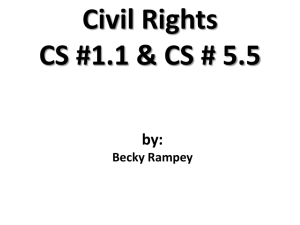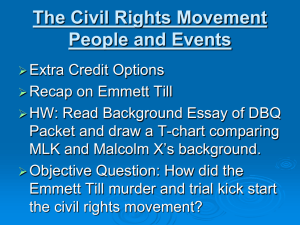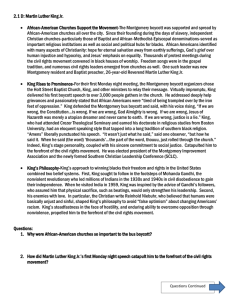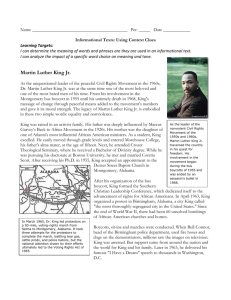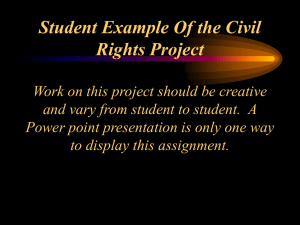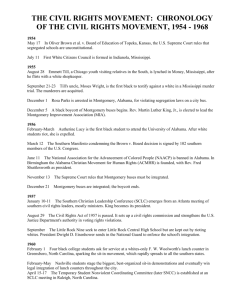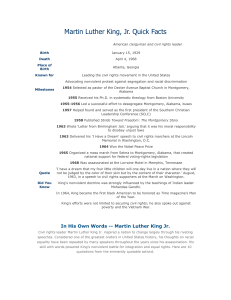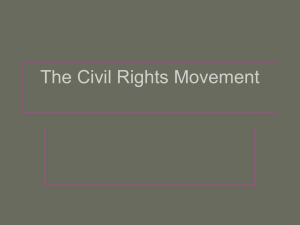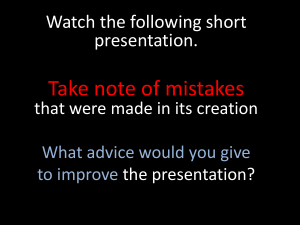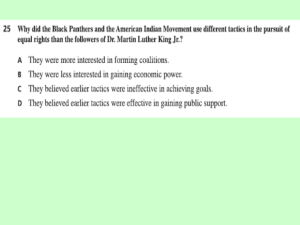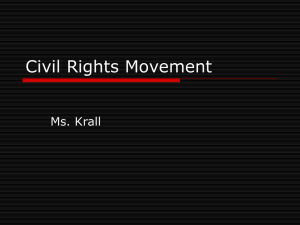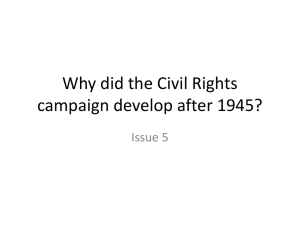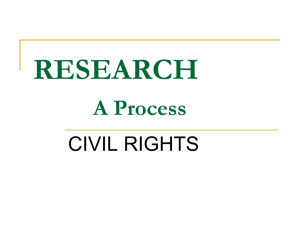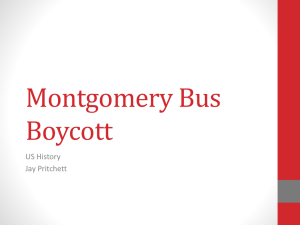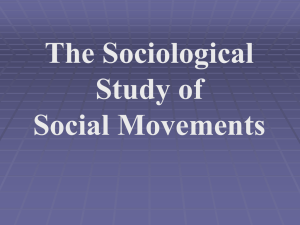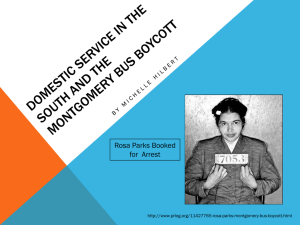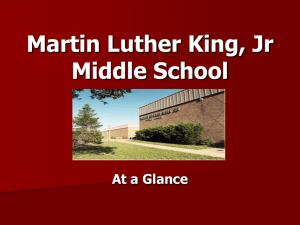File - OASP History
advertisement
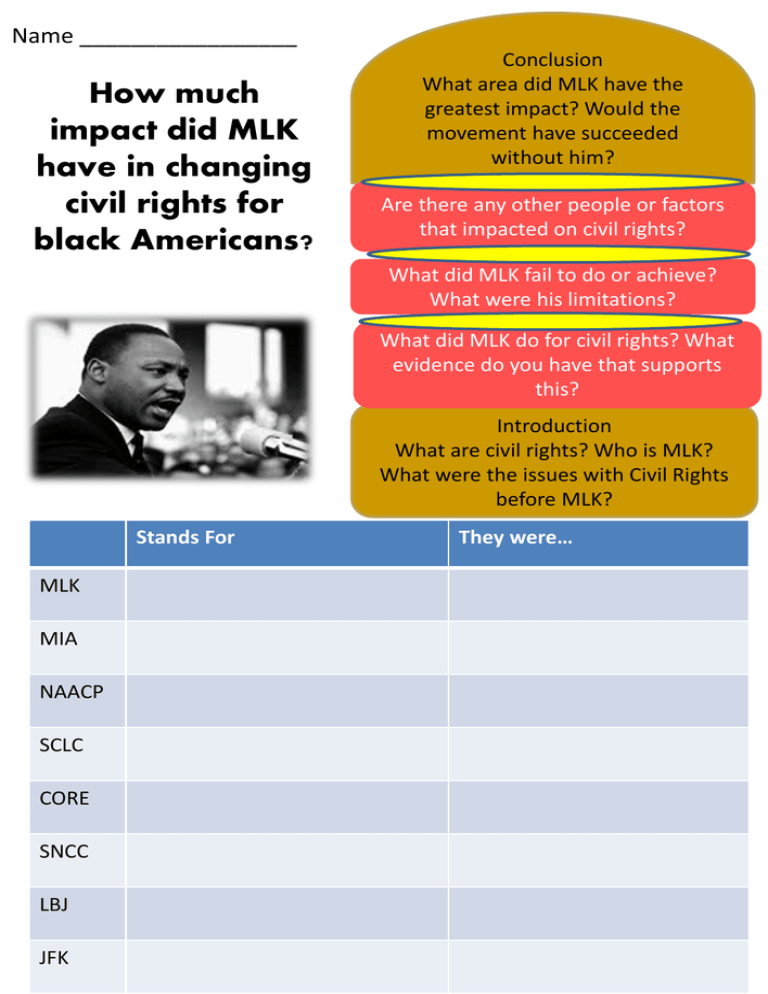
Name _________________ How much impact did MLK have in changing civil rights for black Americans? Conclusion What area did MLK have the greatest impact? Would the movement have succeeded without him? Are there any other people or factors that impacted on civil rights? What did MLK fail to do or achieve? What were his limitations? What did MLK do for civil rights? What evidence do you have that supports this? Introduction What are civil rights? Who is MLK? What were the issues with Civil Rights before MLK? Stands For MLK MIA NAACP SCLC CORE SNCC LBJ JFK They were… Source A On 13 November 1956, while King was in the courthouse being tried on the legality of the boycott’s carpools, a reporter notified him that the U.S. Supreme Court had just affirmed the District Court’s decision on Browder v. Gayle. King addressed a mass meeting at Holt Street Baptist Church the next evening, saying that the decision was ‘‘a reaffirmation of the principle that separate facilities are inherently unequal, and that the old PlessyDoctrine of separate but equal is no longer valid, either sociologically or legally’’ On 17 December 1956, the Supreme Court rejected city and state appeals to reconsider their decision, and three days later the order for integrated buses arrived in Montgomery. On 20 December 1956 King and the Montgomery Improvement Association voted to end the 381-day Montgomery bus boycott. In a statement that day, King said: ‘‘The year-old protest against city buses is officially called off, and the Negro citizens of Montgomery are urged to return to the buses tomorrow morning on a non-segregated basis’’ (Papers 3:486–487). The Montgomery buses were integrated the following day. http://mlk-kpp01.stanford.edu/index.php/encyclopedia/encyclopedia/enc_browder_v_gayle/ Source B King wrote his ‘letter form a Birmingham jail’ in response to a public statement of ‘concern and caution’ issued by eight Southern white religious leaders. Released soon after, King went ahead with a protest march on 3 May 1963. Composed mainly of African-American children and teenagers, the demonstration was planned by SCLC member James Bevel with the intention of filling the already overcrowded prisons with black youths, thereby embarrassing the Birmingham city officials. Civil Rights in America, Ron Field Source C I remember that day in 1963 when Dr King made his famous speech in Washington DC. I was an eight-year-old boy living in Pasadena, California…For a Caucasian boy in a racially segregated city, this was a powerful message. Hopefully, one day, we'll all rise up in the words of the spiritual: "Free at last, free at last. Thank God Almighty, I'm free at last." Mark Praigg, USA http://news.bbc.co.uk/onthisday/hi/witness/august/28/newsid_3171000/3171155.stm Source D “I just happened to be here…If M L King had never been born this movement would have taken place…there comes a time when time itself is ready for change. That time has come in Montgomery, and I had nothing to do with it? — Martin Luther King, 1956 http://mlk-kpp01.stanford.edu/primarydocuments/Vol3/30-Jan1956_MIAMassMeetingNotes.pdf Source E Increasingly pessimistic, King concluded he had overestimated the successes of 1955-65. He said the ‘vast majority’ of whites were racist, ‘hypocritical’, and had committed a kind of ‘psychological and spiritual genocide’ against blacks. King also felt he had underestimated black rage. He was exasperated by militant black racists such as Stokely Carmichael. ‘Many people who would otherwise be ashamed of their anti-Negro feeling now have an excuse.’ Vivienne Sanders, ‘Race Relations in the USA 1863-1980’ 2008 Source F In Greensboro, North Carolina, four black college students spontaneously refused to leave the allwhite Woolworth’s cafeteria when asked. Other students took up and retained their seats, day after day, forcing the cafeteria to close. NAACP was unenthusiastic about helping the students and disgruntled SCLC employee Ella Baker warned them not to let adults like King take over the protest. Hugh Brogan, Access to History: Race Relations in The USA 1863-1980 Source G Dear Sir: The seriousness of this situation demands that immediate steps must be taken to solve this crucial problem, by those who have genuine concern before the racial powder keg explodes… If capitalistic Kennedy and communistic Khrushschev can find something in common on which to form a United Front despite their tremendous ideological differences, it is a disgrace for Negro leaders not to be able to submerge our "minor" differences in order to seek a common solution to a common problem posed by a Common Enemy. …An immediate reply would be appreciated. Your Brother, Malcolm X Malcom X: Letter to Martin Luther King (July 31, 1963) http://www.malcolm-x.org/docs/let_mart.htm Source H ‘LBJ devoted the greatest effort to civil rights..during the first two weeks of his Presidency, he meet with the principal leaders of the civil rights movement – Whitney Young, James Farmer, A Philip Randolph and Martin Luther King Jr. – and warned them to lace up their sneakers because he was going to move so fast on civil rights that they would have trouble keeping up with him. In his memoirs, LBJ explained… ‘There comes a time in every leader’s career when he has to put in all his stack. I decided to shove in all my stack’ on the Civil Rights Act of 1964. Historian Bruce Schulman (1995) The Civil Rights Movement Source I The Greenboro Sit-Ins of 1960 provoked all manner of emotions when they occurred and they remain an important part of civil rights history. Accepting and taking to the limit Martin Luther King’s idea of non-violence and peaceful protests, the sit-ins provoked the type of reaction the Civil Rights movement wanted - public condemnation of the treatment of those involved but also continuing to highlight the issue of desegregation in the South. The sit-ins started in 1960 at Greensboro, North Carolina. http://www.historylearningsite.co.uk/greensboro_1960.htm Source J Photographs of the burning Greyhound bus and the bloodied riders appeared on the front pages of newspapers throughout the country and around the world the next day, drawing international attention to the Freedom Riders’ cause and the state of race relations in the U.S. Following the widespread violence, CORE officials could not find a bus driver who would agree to transport the integrated group, and they decided to abandon the Freedom Rides. http://www.history.com/topics/black-history/freedom-rides Source K The first thing I learned on our Freedom Rides was that most people in the Civil Rights Movement did not have Civil Rights as their number one cause. Everyone, from Jim Zwerg — a white man who was beaten with a lead pipe in Alabama — to Diane Nash — the lead organizer of the second round of the rides — had an underlying loyalty that was the foundation of all their actions in their surface level causes: a loyalty to NonViolence. http://socialcapital.wordpress.com/2012/01/18/the-lessons-of-mlk-jr-and-1961s-freedom-riders/ Source L King had won the Nobel Peace Prize in 1964, and his higher profile would help draw international attention to Selma during the eventful months that followed. On February 18, white segregationists attacked a group of peaceful demonstrators in the nearby town of Marion. In the ensuing chaos, an Alabama state trooper fatally shot Jimmie Lee Jackson, a young African-American demonstrator. In response to Jackson’s death, King and the SCLC planned a massive protest march from Selma to the state capitol of Montgomery, 54 miles away. A group of 600 people set out on Sunday, March 7, but didn’t get far before Alabama state troopers wielding whips, nightsticks and tear gas rushed the group at the Edmund Pettis Bridge and beat them back to Selma. The brutal scene was captured on television, enraging many Americans and drawing civil rights and religious leaders of all faiths to Selma in protest. http://www.history.com/topics/black-history/selma-montgomery-march Source M On 25 March 1965, Martin Luther King led thousands of nonviolent demonstrators to the steps of the capitol in Montgomery, Alabama, after a 5-day, 54-mile march from Selma, Alabama, where local African Americans, the Student Nonviolent Coordinating Committee (SNCC) and the Southern Christian Leadership Conference (SCLC) had been campaigning for voting rights. King told the assembled crowd: ‘‘There never was a moment in American history more honorable and more inspiring than the pilgrimage of clergymen and laymen of every race and faith pouring into Selma to face danger at the side of its embattled Negroes’’ (King, ‘‘Address at the Conclusion of the Selma to Montgomery March,’’ 121). http://mlkkpp01.stanford.edu/index.php/encyclopedia/encyclopedia/enc_selma_to_montgomery_march/ Source O The boycott marked the first major direct-action protest of the post Brown civil rights era and a “decisive turning point” for southern Negroes. While Gayle v. Browder (1956)invalidated bus segregation laws and effectively desegregated Montgomery buses, Klarman downplays the court decisions significance on the modern civil rights movement and highlights the actual boycott as having the lasting impact, noting that the Montgomery bus boycott “demonstrated black agency, resolve, courage, resourcefulness, and leadership” and “enlightened millions of whites about Jim Crow” (372). Michael Klarman, From Jim Crow to Civil Rights What Montgomery Bus Boycott Who was involved? How did it help civil rights? What was the role of MLK? How great was MLK’s impact? (1-5) Explain
